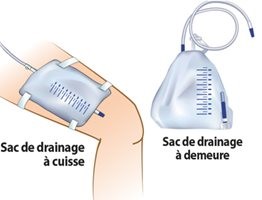Catheter care at home

You will have 2 drainage bags and a catheter holder. The catheter holder keeps the tube in place and attached to your leg. The small bag is for day and the large one is for night.
Use the smaller bag during the day:
- Attach the bag to your leg and make sure it isn’t too tight.
- Make sure the bag is low enough so that the catheter doesn’t twist and stays above the knee.
- Empty the bag every 2 or 3 hours so that it doesn’t overfill.
- Make sure it is never more than ¾ full.
Use the larger bag at night:
- At bedtime, the bag should always be lower than your body so that the urine drains into it.
- Empty your urine bag into the toilet every morning.
Every day, wash the end of the penis (where the catheter goes in) with a washcloth and mild soap. This is recommended to remove any bloody discharge or crust that may form.
Your urine will be tinged with blood after the surgery and you will see small blood clots pass. You must stay hydrated; it is recommended that you drink a minimum of 8 to 10 glasses of fluid per day, unless you have medical restrictions.
You will have your catheter for about 7 to 10 days. When the catheter is removed at the urology clinic, you will need to take an antibiotic that morning to prevent infection. The procedure may make you anxious, but don’t worry; it isn’t painful. The nurse will deflate the balloon and gently tug on the catheter.
Afterward, you may experience:
- Burning when you urinate
- A frequent need to urinate
- Urinary incontinence
- An urgent need to urinate
All of these symptoms are normal and should gradually disappear. To gain better control over your bladder, regularly do your exercises. Remember to urinate as soon as you feel the need.
After your catheter is removed
Resume  your Kegel exercises and adopt goo
your Kegel exercises and adopt goo
- Don’t get into the habit of simply going to the bathroom “just in case.” Only go when you actually need to. A normal schedule is urinating every 3 to 4 hours during the day and before you go to sleep.
- Sit down when you urinate, as this will help empty your bladder.
- Learn how to contract your muscles before sneezing, coughing, laughing or getting up from a chair.
- Avoid over-consuming alcohol, coffee, cola, chocolate and aspartame, which stimulate the bladder.
- Avoid over-stretching the pelvic floor, i.e., don’t bear down too hard when having a bowel movement. Eat plenty of fibre to improve your bowel movements.
- Use the smallest possible incontinence pad in your underwear.
- As you retrain your bladder, use a diary to help you discover any bad habits that you may have developed and to make your urinary habits more regular.
 This guide contains comprehensive information on catheter care (how to maintain it, what to watch for, and more).
This guide contains comprehensive information on catheter care (how to maintain it, what to watch for, and more).